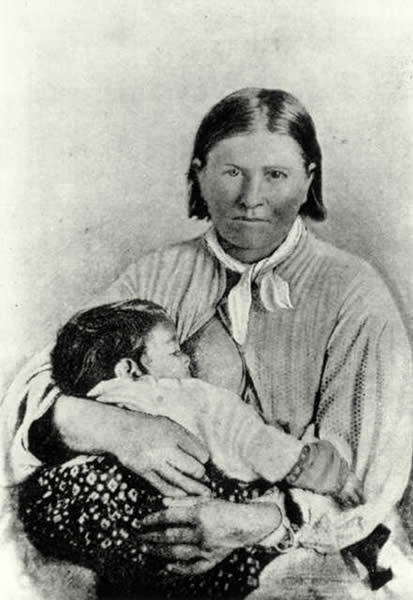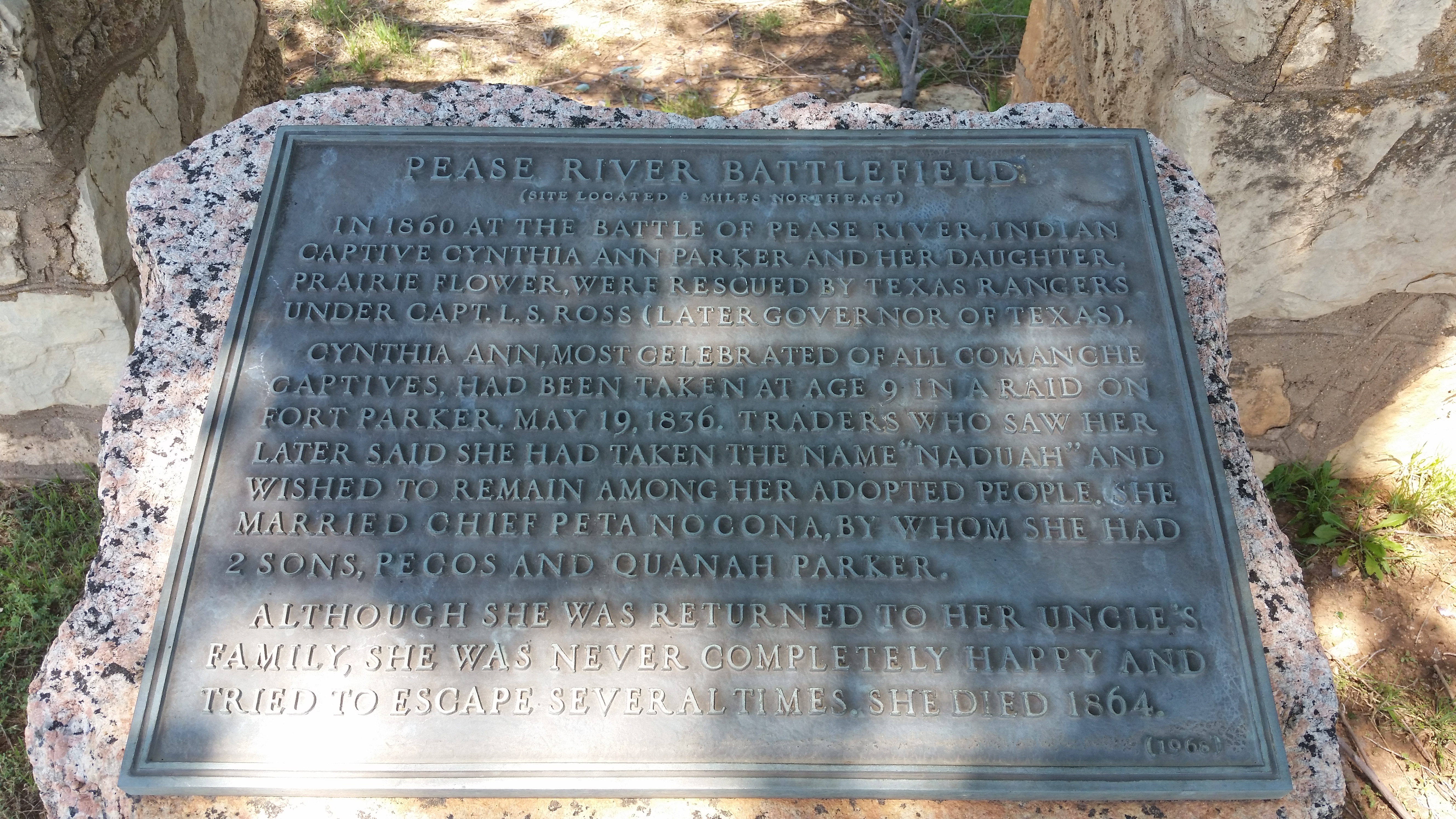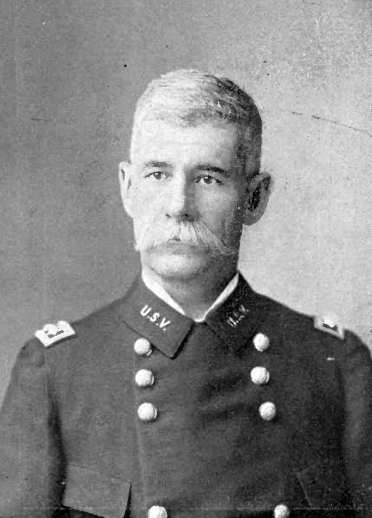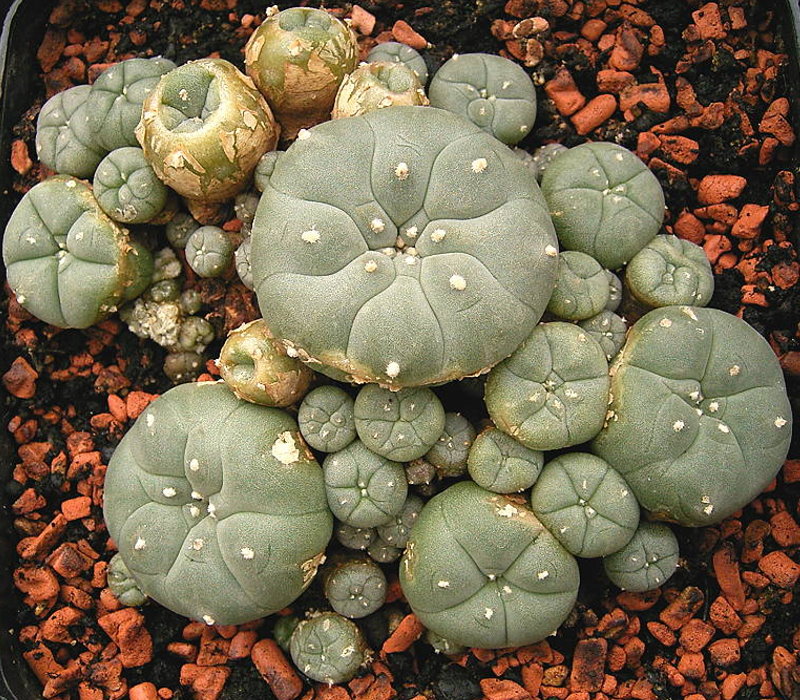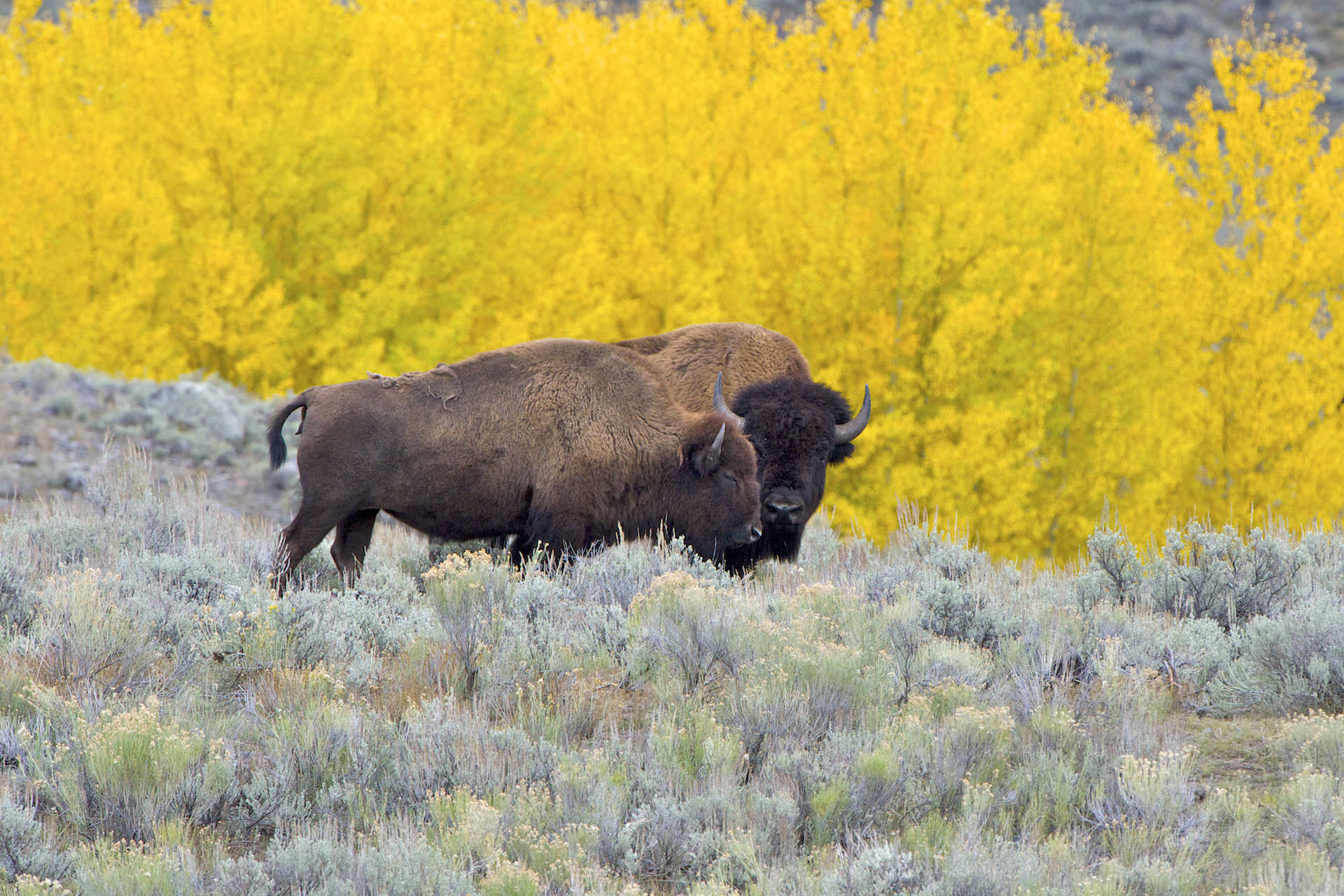|
Quanah Parker
Quanah Parker (, ; – February 23, 1911) was a war leader of the Kwahadi ("Antelope") band of the Comanche Nation. He was likely born into the Nokoni ("Wanderers") band of Tabby-nocca and grew up among the Kwahadis, the son of Kwahadi Comanche chief Peta Nocona and Cynthia Ann Parker, an Anglo-American who had been abducted as an nine-year-old child during the Fort Parker massacre in 1836 and assimilated into the Nokoni tribe. Following the apprehension of several Kiowa chiefs in 1871, Quanah Parker emerged as a dominant figure in the Red River War, clashing repeatedly with Colonel Ranald S. Mackenzie. With European-Americans hunting American bison, the Comanches' primary sustenance, into near extinction, Quanah Parker eventually surrendered and peaceably led the Kwahadi to the reservation at Fort Sill, Oklahoma. Quanah Parker was never elected chief by his people but was appointed by the federal government as principal chief of the entire Comanche Nation. He became a pr ... [...More Info...] [...Related Items...] OR: [Wikipedia] [Google] [Baidu] |
Quanah Parker Star House
The Quanah Parker Star House, with stars painted on its roof, is located in the city of Cache, county of Comanche, in the U.S. state of Oklahoma. It was added in 1970 to the National Register of Historic Places listings in Comanche County, Oklahoma. Background After Comanche chief Quanah Parker's surrender in 1875, he lived for many years in a reservation tipi. Parker decided that he needed living quarters more befitting his status among the Comanches, and more suitable to his position as a spokesperson for the white cattle owners. In order to accommodate his multiple wives and children, this two-story ten-room clapboard house with ten-foot ceilings and a picket fence was constructed for Parker. Request for financial assistance was denied by the United States Government. Parker's friends in the cattle business, in particular 6666 Ranch owner Samuel Burk Burnett, financed the building of the house, circa 1890. Construction The cost of construction was slightly over $2,000 ($48,00 ... [...More Info...] [...Related Items...] OR: [Wikipedia] [Google] [Baidu] |
Comanche
The Comanche (), or Nʉmʉnʉʉ (, 'the people'), are a Tribe (Native American), Native American tribe from the Great Plains, Southern Plains of the present-day United States. Comanche people today belong to the List of federally recognized tribes in the United States, federally recognized Comanche Nation, headquartered in Lawton, Oklahoma. The Comanche language is a Numic languages, Numic language of the Uto-Aztecan languages, Uto-Aztecan family. Originally, it was a Shoshoni language, Shoshoni dialect, but diverged and became a separate language. The Comanche were once part of the Shoshone people of the Great Basin. In the 18th and 19th centuries, Comanche lived in most of present-day northwestern Texas and adjacent areas in eastern New Mexico, southeastern Colorado, southwestern Kansas, and western Oklahoma. Spanish colonists and later Mexicans called their historical territory ''Comancheria, Comanchería''. During the 18th and 19th centuries, Comanche practiced a nomadic h ... [...More Info...] [...Related Items...] OR: [Wikipedia] [Google] [Baidu] |
Anglo-Americans
Anglo-Americans are a demographic group in Anglo-America. It typically refers to the predominantly European-descent nations and ethnic groups in the Americas that speak English as a native language, making up the majority of people in the world who speak English language, English as a first language. Usage The term is ambiguous and used in several different ways. While it is primarily used to refer to people of England, English ancestry, it (along with terms like ''Anglo'', ''Anglic'', ''English-speaking world, Anglophone'', and ''Anglophonic'') is also used to denote all people of British or Northwestern European ancestry. It can include all people of Northwestern European ethnic origin who speak English as a mother tongue and their descendants in the New World.Mish, Frederic C., Editor in Chief ''Webster's Tenth New Collegiate Dictionary'' Springfield, Massachusetts, U.S.A.:1994--Merriam-Webster See original definition (definition #1) of ''Anglo'' in English: It is defined as ... [...More Info...] [...Related Items...] OR: [Wikipedia] [Google] [Baidu] |
Comanche Wars
The Comanche Wars were a series of armed conflicts fought between Comanche peoples and Kingdom of Spain, Spanish, Mexico, Mexican, and United States, American militaries and civilians in the United States and Mexico from as early as 1706 until at least the mid-1870s. The Comanche were the Indigenous peoples of the Americas, Native American inhabitants of a large area known as Comancheria, which stretched across much of the southern Great Plains from Colorado and Kansas in the north through Oklahoma, Texas, and eastern New Mexico and into the Mexican state of Chihuahua (state), Chihuahua in the south. For more than 150 years, the Comanche were the dominant native tribe in the region, known as “the Lords of the Southern Plains”, though they also shared parts of Comancheria with the Wichita people, Wichita, Kiowa people, Kiowa, and Plains Apache, Kiowa Apache and, after 1840, the southern Cheyenne and Arapaho. The value of the Comanche traditional homeland was recognized by Europe ... [...More Info...] [...Related Items...] OR: [Wikipedia] [Google] [Baidu] |
Lone Wanderer
Peta Nocona, also known as Puhtocnocony, or Tah-con-ne-ah-pe-ah ( – 1864), the son of ''Puhihwikwasu'u'', or Iron Jacket, was a chief of the Comanche Quahadi (also known as Kwahado, Quahada) band. He married Cynthia Ann Parker, who had been taken as a captive during the Fort Parker massacre in 1836 and was adopted into the tribe by Tabby-nocca's family. Among their three children was Quanah Parker, the last war chief of the Comanche. Peta Nocona chose his wife from among the members of the Nokoni band. He led his tribe during the extensive Indian Wars in Texas, from the late 1840s until the 1860s, as the United States tried to suppress his people. He was the son of the Quahadi Comanche chief Iron Jacket. He became so renowned that a legend said that "his" band, the Nokoni (or Wanderers, or Travellers) band, were named for him, but the name of the Nokoni people had long antedated him, and, anyway, he was a Kwahadi, having a Nokoni wife. The city of Nocona, Texas is named after hi ... [...More Info...] [...Related Items...] OR: [Wikipedia] [Google] [Baidu] |
Groesbeck, Texas
Groesbeck ( ) is a city in and the county seat of Limestone County, Texas, United States. Located along Texas State Highway 14 and Texas State Highway 164, it sits in the northern part of the Texas Triangle. Its population was 3,631 at the 2020 census. History The Tawakoni, who are part of the Wichita people, are attested living between the Trinity and Brazos Rivers since at least 1768. European colonization Limestone county was a part of the Empresario grants given out by the government of Coahuila y Tejas, with Haden Edwards given permission to settle an area including most of Limestone County in 1825, but the Mexican government legally forbade Anglo-Americans from settling into Mexican Texas after the Law of April 6, 1830. Settlement continued however, including in 1833 when a group of Anglos from Illinois settled Fort Parker, the earliest known European settlement in the vicinity. Numerous Mexican and Anglo settlers made land claims in the area before 1836. After 1836 ... [...More Info...] [...Related Items...] OR: [Wikipedia] [Google] [Baidu] |
Fort Parker Massacre
The Fort Parker massacre, also known as the Fort Parker raid, was an event in which a group of Texian colonists were killed in an attack by a contingent of Comanche, Kiowa, Caddo, and Wichita raiders at Fort Parker on May 19, 1836. During the attack, Cynthia Ann Parker, then approximately nine years old, was captured and spent most of the rest of her life within the Comanche Nation, later marrying Chief Peta Nocona and giving birth to three children, including a son, Quanah Parker, who became a prominent leader of the Comanches and a war leader during the Red River War of 1874–75. Cynthia’s brother John Richard Parker was also captured and remained with the Comanches for six years before his release was negotiated. He was unable to readapt to Western society and chose to return to the Comanche Nation. Background Fort Parker was established about north of present-day Groesbeck, Limestone County, Texas, United States, by John Parker, his sons, Benjamin, Silas and J ... [...More Info...] [...Related Items...] OR: [Wikipedia] [Google] [Baidu] |
Texas
Texas ( , ; or ) is the most populous U.S. state, state in the South Central United States, South Central region of the United States. It borders Louisiana to the east, Arkansas to the northeast, Oklahoma to the north, New Mexico to the west, and has Mexico-United States border, an international border with the Mexican states of Chihuahua (state), Chihuahua, Coahuila, Nuevo León, and Tamaulipas to the south and southwest. Texas has Texas Gulf Coast, a coastline on the Gulf of Mexico to the southeast. Covering and with over 31 million residents as of 2024, it is the second-largest state List of U.S. states and territories by area, by area and List of U.S. states and territories by population, population. Texas is nicknamed the ''Lone Star State'' for its former status as the independent Republic of Texas. Spain was the first European country to Spanish Texas, claim and control Texas. Following French colonization of Texas, a short-lived colony controlled by France, Mexico ... [...More Info...] [...Related Items...] OR: [Wikipedia] [Google] [Baidu] |
Horseback (Comanche)
Horseback (Comanche, Tʉhʉya Kwahipʉ or Kiyou ''horse back'') (1805/1810-1888) was a Nokoni Comanche chief. Young man: warrior and war chief In his prime, he made his career under the elder Huupi-pahati (Tall Tree), head chief of the Nokoni band, and Quenah-evah (Eagle Drink), second chief and later successor to Huupi-pahati himself possibly after the smallpox and cholera epidemics occurred in 1849; during the 1840s and 1850s he gained a good fame as a war leader against the Comanche's Indian enemies and a raider through Texas. Diplomat and peaceful leader In 1861, along with the Yamparika head chief Ten Bears and the Penateka chiefs Tosahwi (White Knife) and Asa-havey a.k.a. Esihabit (Milky Way), went to Fort Cobb where they met General Albert Pike (C.S.A.), and the Comanche chiefs (including Quena-evah) signed for an allegiance with the Confederate States of America.Wallace, Ernest & Hoebel, E. Adamson. The Comanche: Lords of the Southern Plains, University of Oklahoma Press, ... [...More Info...] [...Related Items...] OR: [Wikipedia] [Google] [Baidu] |
Lawton, Oklahoma
Lawton is a city in and the county seat of Comanche County, Oklahoma, Comanche County, in the U.S. state of Oklahoma. Located in western Oklahoma, approximately southwest of Oklahoma City, it is the principal city of the Lawton metropolitan area, Lawton, Oklahoma, metropolitan statistical area. According to the 2020 United States census, 2020 census, Lawton's population was 90,381, making it the sixth-largest city in the state, and the largest in Western Oklahoma. Developed on former Indian reservation, reservation lands of the Kiowa, Comanche, and Fort Sill Apache Tribe, Apache peoples, Lawton was incorporated in 1901. It was named after Major General Henry Ware Lawton, who served in the Civil War, where he earned the Medal of Honor, and was killed in action in the Philippine–American War. Lawton's landscape is typical of the Great Plains, with flat topography and gently rolling hills, while the area north of the city is marked by the Wichita Mountains. The city's proximity ... [...More Info...] [...Related Items...] OR: [Wikipedia] [Google] [Baidu] |
Peyote
The peyote (; ''Lophophora williamsii'' ) is a small, spineless cactus which contains psychoactive alkaloids, particularly mescaline. is a Spanish word derived from the Nahuatl (), meaning "caterpillar cocoon", from a root , "to glisten". p. 246. See peyotl in Wiktionary. It is native to southern North America, primarily found in desert scrub and limestone-rich areas of northern Mexico and south Texas, particularly in the Chihuahuan Desert at elevations of 100–1500 meters. It flowers from March to May, and sometimes as late as September. Its flowers are pink or white, with thigmotactic anthers (like ''Opuntia''). It is a small, spineless cactus that grows in clusters, produces edible fruits, and contains psychoactive alkaloids—primarily mescaline—at concentrations of about 0.4% when fresh and up to 6% when dried. Peyote is a slow-growing cactus that can be cultivated more rapidly through techniques such as grafting, and while wild populations in regions like south ... [...More Info...] [...Related Items...] OR: [Wikipedia] [Google] [Baidu] |
American Bison
The American bison (''Bison bison''; : ''bison''), commonly known as the American buffalo, or simply buffalo (not to be confused with Bubalina, true buffalo), is a species of bison that is endemic species, endemic (or native) to North America. It is one of two extant species of bison, along with the European bison. Its habitat, historical range ''circa'' 9000 BC is referred to as the great bison belt, a tract of rich grassland spanning from Alaska south to the Gulf of Mexico, and east to the Atlantic Seaboard (nearly to the Atlantic tidewater (geographic term), tidewater in some areas), as far north as New York (state), New York, south to Georgia (U.S. state), Georgia, and according to some sources, further south to northern Florida, with sightings in North Carolina near Buffalo Ford on the Catawba River as late as 1750. Two subspecies or ecotypes have been described: the plains bison (''B. b. bison''), smaller and with a more rounded hump; and the wood bison (''B. b. athabascae ... [...More Info...] [...Related Items...] OR: [Wikipedia] [Google] [Baidu] |
